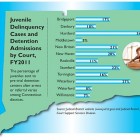Disparities
Child Advocates Want Independent Review of Girls’ Detention Unit
|
A preliminary review by the Office of the Child Advocate of conditions at the state’s controversial locked treatment program for troubled girls in Middletown raises concerns about the improper use of restraints, inadequate access to mental health services, and inconsistent reporting of abuse and neglect. The report, which was distributed to members of the Connecticut Juvenile Training School (CJTS) Advisory Committee and obtained by the Connecticut Health I-Team, cites concerns that youths in both the 12-bed girls’ Pueblo Unit and the larger CJTS facility for boys have been subjected to inappropriate or unsafe restraint, including the use of “prone restraint” on youths with respiratory problems. Prone restraint means that a person is laid in a facedown position. “I know that DCF (the Department of Children and Families) shares our concern regarding the use of potentially dangerous restraint for children with contraindicated medical conditions,” Child Advocate Sarah Eagan wrote. “Our review of these incident reports raises questions regarding the adequacy of staff training on the use of restraint (and de-escalation strategies), and the effective dissemination of critical information regarding children’s special health care needs.”
The report echoes concerns about the CJTS’ use of restraint that were cited in a report a decade ago by the former child advocate and attorney general’s office. The new review comes just six months after the girls’ facility opened — and as state agencies seek to reduce the unnecessary use of restraint among children.
